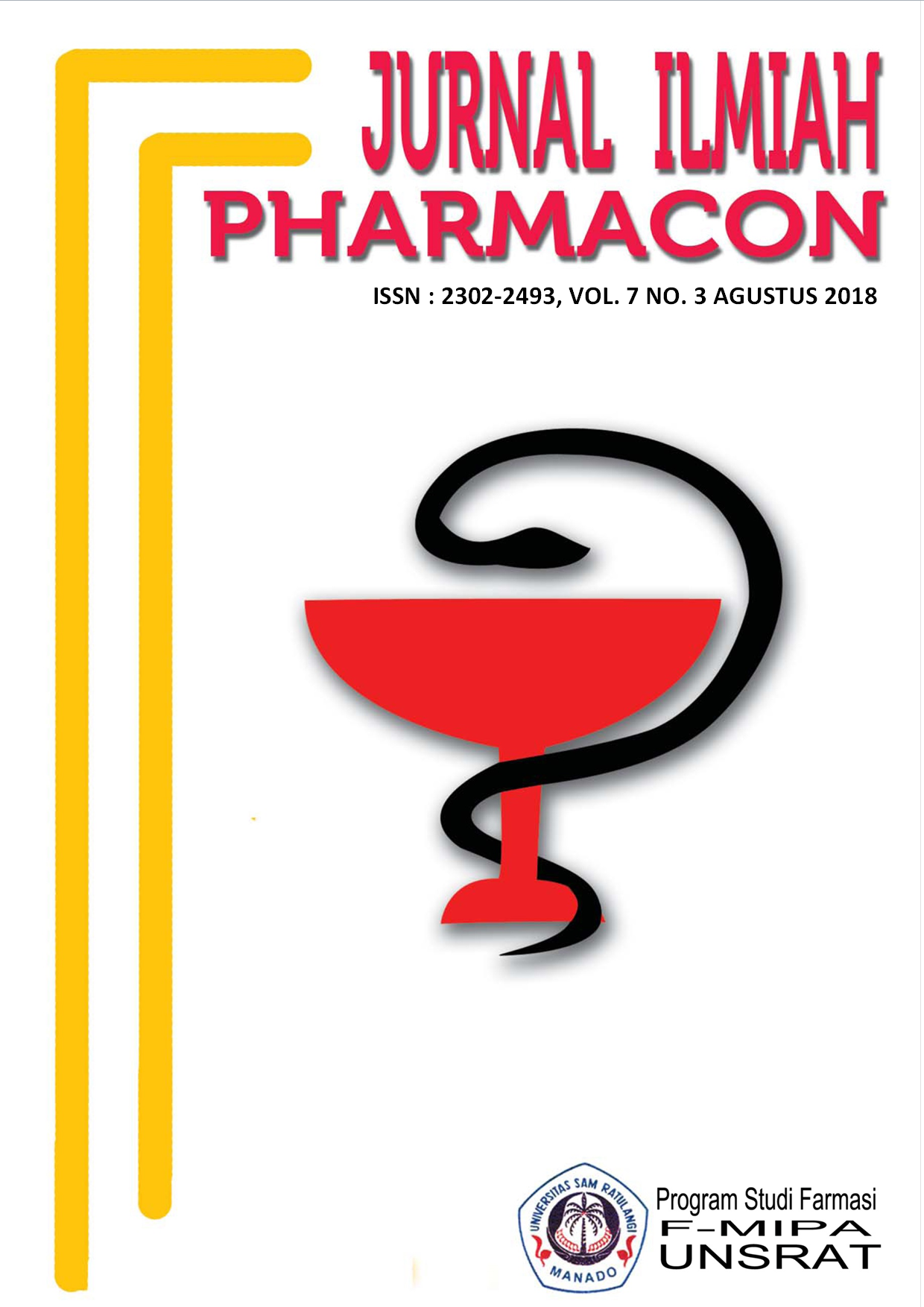UJI DAYA HAMBAT PERASAN BUAH SRIKAYA (Annona Squamosa L) TERHADAP PERTUMBUHAN Candida albicans
DOI:
https://doi.org/10.35799/pha.7.2018.20100Abstract
UJI DAYA HAMBAT PERASAN BUAH SRIKAYA (Annona Squamosa L) TERHADAP PERTUMBUHAN Candida albicans
Rendy Mamitoho1), P. L. Suling1), Christy Mintjelungan1)
1 Program Studi Pendidikan Dokter Gigi Fakultas Kedokteran Unsrat Manado, 95115
ABSTRACT
Natural treatments derived from plants have been shown to be safe reliable have relatively small side effects. Medicinal plants are plants that one or all parts of the plant contains active ingredients that are efficacious for health that can be used as a healing disease, the plant part in the intention is the leaves, fruit, flowers, roots, stems (skin) and resin (resin) . Plants are often used by the people of North Sulawesi as an alternative in treating diseases, one of them is as an antifungal and antibacterial. Sugar apple (Annona Squamosa L) is one kind of plant that is used as an antifungal alternative medicine. Based on research on the pharmacological activities of Annona squamosa, sugar apple (Annona squamosa) has effect as anticancer, antiinflammatory, antibacterial and antifungal. The purpose of this study was to determine the inhibition of sugar apple (Annona squamosa L) to the growth of Candida albicans. This study is an experimental research laboratory, using true experimental designs with post test only control group design. Testing method using Kirby-bauer method by filterpaper.. Samples of sugar apple (Annona squamosa L) squeezed then filtered and stored in a sterile sealed glass bottles. Candida albicans was taken from pure stock Pharmacy Laboratory Faculty of Math and Science, University of Sam Ratulangi. The results of this study obtained inhibition zone diameter sugar apple (Annona squamosa L) on the growth of Candida albicans in the amount 21 mm which is strong inhibition category. As the conclution, sugar apple (Annona Squamosa L.) has an inhibitory effect on Candida albicans fungus growth.
Keywords : sugar apple (Annona squamosa L), Candida albicans, inhibition zone
ABSTRAK
Pengobatan herbal yang berasal dari tumbuh-tumbuhan telah terbukti aman terpercaya memiliki efek samping yang relatif kecil. Tumbuhan obat yaitu tumbuhan yang salah satu atau seluruh bagian pada tumbuhan tersebut mengandung zat aktif yang berkhasiat bagi kesehatan yang dapat dimanfaatkan sebagai penyembuh penyakit, bagian tumbuhan yang di maksud ialah daun, buah, bunga, akar, batang (kulit) dan getah (resin). Tanaman seringkali digunakan oleh masyarakat Sulawesi Utara sebagai alternatif dalam mengobati penyakit, salah satunya ialah sebagai anti jamur dan anti bakteri. Buah srikaya (Annona Squamosa L) merupakan salah satu jenis tanaman yang dipakai sebagai obat alternatif anti jamur. Berdasarkan penelitian pada pharmacological activities of annona squamosa, buah srikaya memiliki efek sebagai antikanker, antiinflamasi, antibakterial dan antifungi. Tujuan penelitian ini yaitu untuk mengetahui daya hambat perasan buah srikaya terhadap pertumbuhan jamur Candida Albicans. Penelitian ini merupakan penelitian experimental laboratorium, dengan menggunakan rancangan eksperimental murni (true eksperimental design) dengan rancangan penelitian post test only control group design. Metode pengujian menggunakan metode Kirby-bauer berbahan kertas saring. Sampel buah srikaya diperas dan disaring serta disimpan dalam botol kaca steril. Jamur Candida albicans diambil dari stok biakan jamur murni Laboratorium Farmasi FMIPA Universitas Sam Ratulangi Manado. Hasil penelitian ini didapat diameter zona hambat perasan buah srikaya (Annona Squamosa L) pada pertumbuhan Candida albicans yaitu sebesar 21 mm dan tergolong dalam kriteria zona hambat kuat. Kesimpulannya perasan buah srikaya (Annona Squamosa L) mempunyai daya hambat terhadap pertumbuhan jamur Candida albicans.
Kata kunci : Buah srikaya (Annona Squamosa L), Candida albicans, Zona hambat.
Downloads
Published
How to Cite
Issue
Section
License
Authors who publish with this journal agree to the following terms:
- Authors retain copyright and grant the journal right of first publication with the work simultaneously licensed under a Creative Commons Attribution-NonCommercial 4.0 International License that allows others to share the work with an acknowledgement of the work's authorship and initial publication in this journal.
- Authors are permitted and encouraged to post their work online (e.g., in institutional repositories or on their website) prior to and during the submission process, as it can lead to productive exchanges, as well as earlier and greater citation of published work (See The Effect of Open Access)










